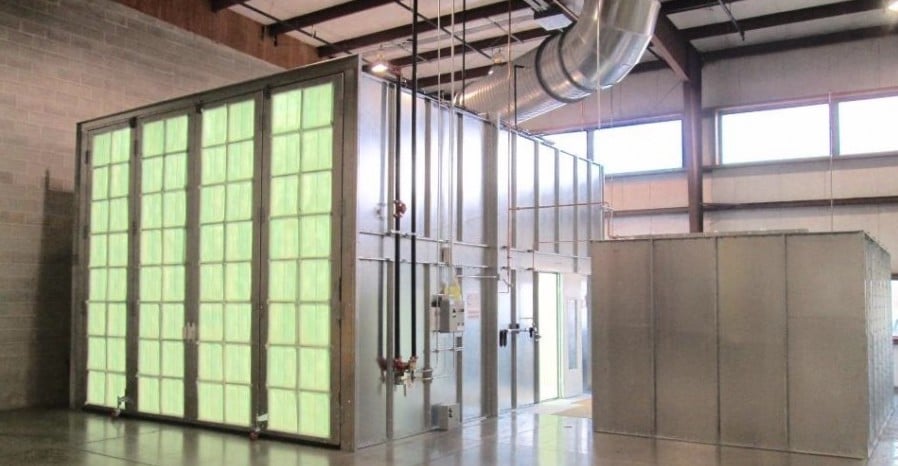Guide to Custom Metal Fabrication Finishes

One of the final steps in the custom metal fabrication process is the application of a finish. This step typically serves multiple purposes, not the least of which is increased durability and decorative appeal. It can also serve to clean surfaces and prep them for painting and can even improve electrical conductivity when needed.
There are numerous types of equipment used in the metal fabrication process, including finishing equipment. This guide to metal finishing types is intended to provide a general overview of common techniques used for the defense industry and other industrial applications.
Sandblasting
Sandblasting, sometimes referred to as abrasive blasting or bead blasting, uses extremely high pressure to propel sand, metal pellets, or other abrasives onto a metal substrate at high speed. The result is a smooth, matte texture.
Unlike other finishes mentioned above, sandblasting won’t improve durability. It is often used as a pre-finishing technique to improve appearance and ensure a surface is free of oil, rust, mill scale, and other contaminants to improve adhesion of a final finish coat.
Powder Coated Metal
As its name suggests, powder coating involves the application of a dry plastic powder that is melted onto a metal surface. The technique typically uses an electrostatic charge to apply the coating which is cured using heat or ultraviolet light. In addition to providing a decorative finish in varying textures, it is also extremely durable.
Powder coating can be applied to most metals and is generally more economical than other finishing processes. It is well suited for fabrications that have a complex design or irregular shape and size.
Painting
Unlike a powder coating, painting is a wet application, and the types of paint finishes available are practically innumerable. Some paint finishes can be as lustrous as a new car finish whereas others are more appropriate for industrial applications and the Defense Department. For example, many military applications like electrical enclosures, trailers, vehicles, aircraft, and ships typically use a matte epoxy or enamel paint in battleship gray or other Federal Standard and Military CARC paint colors.
Prior to painting, a pre-treatment is often applied, such as an iron phosphate coating. This step removes traces of oils or mill scale so that the primer and paint will adhere properly. Often underappreciated is the importance of detailed masking. For some defense applications, masking may be required to a tolerance within .001 inch, making the tedious masking process as important as the painting itself.
Of note is that Fox Valley Metal-Tech’s in-house painting facilities meet CARC military specifications, and Raytheon and Lockheed Martin have audited their systems and processes to ensure they comply with their standards.
Anodized Metal
An aluminum anodized finish uses an electrochemical process that applies aluminum oxide to alter the metal’s surface rather than applying a paint or coating. There’s no risk of flaking or chipping because the oxidation is an integral part of the metal. Aluminum is typically considered a softer material in custom metal fabrication, but the anodization process makes it three times harder than its raw state. Anodized aluminum resists corrosion, abrasions, and UV damage, and is available in different colors and finishes.
Metal Plating
There are numerous types of metal plating used for various industries, but in complex custom metal fabrication, it typically refers to galvanized metal or the chemical conversion process. In general, metal plating uses a chemical bath to alter or coat the surface with a thin layer of metal. In all cases, the intent is to improve corrosion resistance and appearance.
Galvanized metal is the process of dipping a product into molten zinc which protects the integrity of the underlying substrate. A chemical conversion coating may include applying chromate to a metal substrate which, in addition to improving durability, also improves electrical conductivity. A black oxide finish is another process that results in a matte black finish that minimizes light reflection.
For defense projects, the use of NADCAP-accredited suppliers or approved Raytheon or Northrop Grumman sources are typically required. These are, in essence, the military’s equivalent to ISO standards.
Polishing
Another type of abrasive finish is electropolishing and metal polishing, which use various methods to turn a metal’s surface into a fine luster. Typical metal polishing may use mechanical abrasive methods like a buffer or fine grinder, which can produce a mirror-like finish. Electropolishing, however, uses a concentrated acid solution to remove inclusions and other imperfections to reduce surface roughness. Like sandblasting, it serves more of an aesthetic purpose.
There are a variety of other finishing techniques used in the metal fabrication industry, like brushed stainless steel, but those included here are among the most commonly used for defense projects.
Designating the proper finish is just one step in the RFQ process. We’ve included additional considerations in our Metal Fabrication RFQ Checklist below. Use it to develop a more complete RFQ and receive a more accurate quote. Then, reach out to our metal fabrication experts to talk through your next project.
